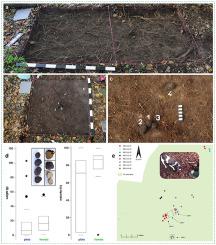Fungal Biology ( IF 2.5 ) Pub Date : 2021-09-03 , DOI: 10.1016/j.funbio.2021.09.001 Ulf Büntgen 1 , Martina Peter 2 , Willy Tegel 3 , Ulrich Stobbe 4 , Rengert Elburg 5 , Ludger Sproll 4 , Virginie Molinier 2 , Tomáš Čejka 6 , Elizabeth L Isaac 7 , Simon Egli 2

|
Despite its status as a highly-prized and coveted fungi in gastronomy, many aspects of the subterranean life cycle of the Burgundy truffle (Tuber aestivum) are still unknown, because in situ observations of the formation and maturation of truffle fruitbodies remain difficult. Here, we adopted a suite of archaeological fine-scale excavating techniques to provide unique spatiotemporal snapshots of Burgundy truffle growth at three sites in southern Germany. We also recorded the relative position, fresh weight, maturity level and genotype composition of all excavated fruitbodies. Varying by a factor of thousand, the fresh weight of 73 truffle ranged from 0.1 to 103.2 g, with individual maturity levels likely representing different life cycle stages from completely unripe to fully ripe and even decaying. While only a slightly positive relationship between fruitbody weight and maturity level was found, our results suggest that genetically distinct specimens can exhibit different life cycle stages at the same period of time and under the same environmental conditions. We therefore argue that truffles are likely able to grow, mature and ripe simultaneously between early summer and late winter of the following year. Our case study should encourage further eco-archaeological truffle excavations under different biogeographic settings and at different seasons of the year to gain deeper insights into the fungi's subterranean ecology. The expected cross-disciplinary findings will help truffle hunters and farmers to improve their harvest practices and management strategies.
中文翻译:

生态考古挖掘技术揭示了地下松露生长的快照
尽管它在美食界是一种备受推崇和令人垂涎的真菌,但勃艮第松露 ( Tuber aestivum ) 地下生命周期的许多方面仍然未知,因为原位观察松露子实体的形成和成熟仍然很困难。在这里,我们采用了一套考古精细挖掘技术,提供了德国南部三个地点勃艮第松露生长的独特时空快照。我们还记录了所有出土子实体的相对位置、鲜重、成熟度和基因型组成。73 块松露的鲜重相差千倍,从 0.1 到 103.2 克不等,个体成熟度可能代表从完全未成熟到完全成熟甚至腐烂的不同生命周期阶段。虽然发现子实体重量和成熟度之间只有轻微的正相关关系,我们的研究结果表明,基因不同的标本可以在相同的时间段和相同的环境条件下表现出不同的生命周期阶段。因此,我们认为松露很可能能够在初夏和次年冬末之间同时生长、成熟和成熟。我们的案例研究应该鼓励在不同的生物地理环境和一年中的不同季节进行进一步的生态考古松露挖掘,以更深入地了解真菌的地下生态。预期的跨学科研究结果将帮助松露猎人和农民改进他们的收获实践和管理策略。我们的案例研究应该鼓励在不同的生物地理环境和一年中的不同季节进行进一步的生态考古松露挖掘,以更深入地了解真菌的地下生态。预期的跨学科研究结果将帮助松露猎人和农民改进他们的收获实践和管理策略。我们的案例研究应该鼓励在不同的生物地理环境和一年中的不同季节进行进一步的生态考古松露挖掘,以更深入地了解真菌的地下生态。预期的跨学科研究结果将帮助松露猎人和农民改进他们的收获实践和管理策略。


























 京公网安备 11010802027423号
京公网安备 11010802027423号